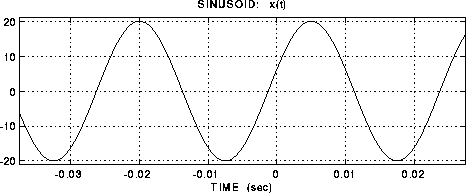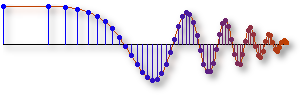Overview: In chapter two, the most basic waveform in
signal processing, the cosine wave, is presented. The
mathematical formula for the cosine wave, in its most general form
is given below:
$$x(t)=A \cos(2 \pi f_0 t + \varphi)$$
Where \(x(t)\) is a function of the
time variable \(t\). The
amplitude of the cosine is given by the real number \(A\).
The frequency
of the of the cosine wave is \(f_0\),
and in the audio experiments that follow, it is the frequency that determines
what we hear. Finally, the phase of the sinusoid
is given by the parameter \(\varphi\).
A plot of a cosine is given in the figure below:

$$x(t)= A e^{j(2 \pi f_0 t + \varphi)}$$
The generalization to complex exponentials is important for later work in Fourier analysis, so we are laying a foundation for the future. The real part of the complex exponential is a cosine, and its imaginary part is the sine function, so a plot of the complex exponential is a rotating vector with a constant length \(A\). This signal is called a rotating phasor.Demos - MATLAB 6
Demos - LabVIEW 3
Labs - MATLAB 4
In this lab we introduce the fundamentals of Matlab. Matlab is
a programming environment that you will find helpful for many of
the exercises in this text.
Manipulating sinusoid functions using complex exponentials turns
trigonometric problems into simple arithmetic and algebra.
In this lab, we first review the complex exponential signal and the
phasor addition property needed for adding cosine waves.
Then we will use Matlab to make plots of phasor diagrams that show
the vector addition needed when combining sinusoids.
Manipulating sinusoid functions using complex exponentials turns
trigonometric problems into simple arithmetic and algebra.
In this lab, we first review the complex exponential signal and the
phasor addition property needed for adding cosine waves.
Then we will use Matlab to make plots of phasor diagrams that show
the vector addition needed when combining sinusoids.
[Files]
The objective of this lab is to learn how the outputs from two spatially separated sensors that
receive signals from the same source can be used to estimate the direction to the source of the signal. The
key to this processing is phase difference or time difference of arrival (TDOA) at the two receivers.
[Files]
Labs - LabVIEW 2
In this lab we introduce the fundamentals of LabVIEW. LabVIEW is
a programming environment that you will find helpful for many of
the exercises in this text.
Manipulating sinusoid functions using complex exponentials turns
trigonometric problems into simple arithmetic and algebra.
In this lab, we first review the complex exponential signal and the
phasor addition property needed for adding cosine waves.
Then we will use Matlab to make plots of phasor diagrams that show
the vector addition needed when combining sinusoids.
[Files]










